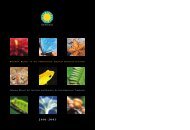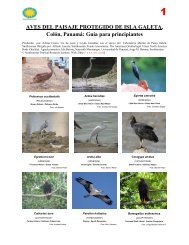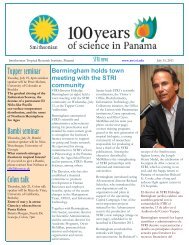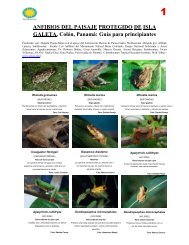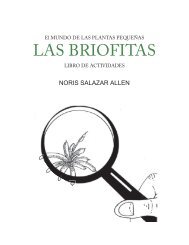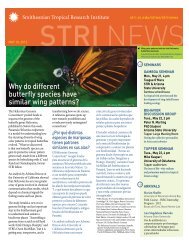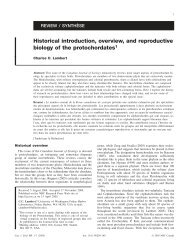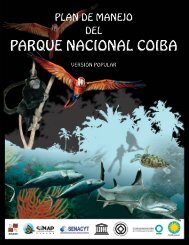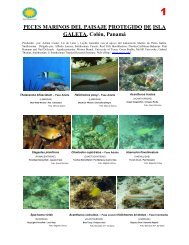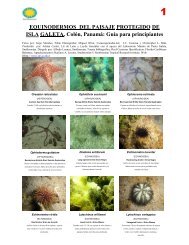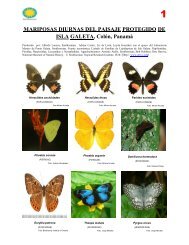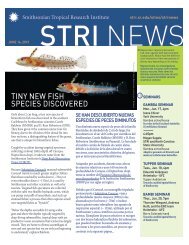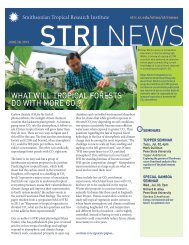NEO symposium Tupper seminar Bambi seminar - Smithsonian ...
NEO symposium Tupper seminar Bambi seminar - Smithsonian ...
NEO symposium Tupper seminar Bambi seminar - Smithsonian ...
You also want an ePaper? Increase the reach of your titles
YUMPU automatically turns print PDFs into web optimized ePapers that Google loves.
More arrivals<br />
Martyn Slot, University of<br />
Florida, to study temperature<br />
responses of leaf dark<br />
respiration and their<br />
implication for tropical forest<br />
carbon balance, at <strong>Tupper</strong> and<br />
Gamboa.<br />
Whitney Nagel, University of<br />
North Carolina, to study<br />
ecological impact and<br />
parasitism in the invasive<br />
lionfish, Pterois volitans, in<br />
Panamanian coasts, at Bocas<br />
del Toro and Galeta.<br />
Alex Pasquini, University of<br />
North Carolina, to study<br />
molecular evolution of sea<br />
urchins, at Bocas del Toro<br />
and Naos Island Laboratories.<br />
Maryna Lesoway, McGill<br />
University, to study the<br />
evolutionary biology of the<br />
Calyptraeid gastropods, at<br />
Naos Island Laboratories.<br />
STRI in the news<br />
“ScienceShot: A buzz in the<br />
dark” by Sara Reardon. 2011.<br />
Science NOW (July 26):<br />
http://news.sciencemag.org/s<br />
ciencenow/2011/07/sciences<br />
hot-a-buzz-in-the-dark.html<br />
New publications<br />
Chisholm, Ryan A. 2011.<br />
"Time-dependent solutions of<br />
the spatially implicit neutral<br />
model of biodiversity."<br />
Theoretical Population Biology<br />
80(2): 71-79.<br />
Glynn, Peter William, Colley,<br />
Susan B., Guzman, Hector<br />
M., Enochs, Ian C., Cortes,<br />
Jorge, Mate T., Juan L., and<br />
Feingold, J.S. 2011. "Reef<br />
coral reproduction in the<br />
eastern Pacific: Costa Rica,<br />
Panama, and the Galapagos<br />
Islands (Ecuador). VI.<br />
Agariciidae, Pavona clavus."<br />
Marine Biology 158(7):<br />
1601-1617.<br />
Back-packing toucans assist<br />
tropical researchers<br />
Nutmeg-loving toucans wearing<br />
GPS transmitters recently helped<br />
a team of scientists at STRI<br />
address an age-old problem in<br />
plant ecology: Accurately<br />
estimating seed dispersal. The<br />
tracking data revealed what<br />
scientists have long suspected:<br />
toucans are excellent seed<br />
dispersers, particularly in the<br />
morning.<br />
The researchers collected fresh<br />
seeds from a common<br />
Panamanian nutmeg tree and fed<br />
them to captive toucans at the<br />
Rotterdam Zoo. They gulp<br />
nutmeg seeds whole, the outer<br />
pulp is processed in the bird's<br />
crop, and the hard inner seed is<br />
then regurgitated. Five zoo<br />
toucans fed 100 nutmeg seeds<br />
took an average of 25.5 minutes<br />
to process and regurgitate the<br />
seeds.<br />
In Panama, the scientists netted<br />
six wild toucans that were<br />
feeding from a large nutmeg tree<br />
in Gamboa. They fitted the birds<br />
with lightweight backpacks<br />
containing GPS tracking devices<br />
and accelerometers which can<br />
measure a bird's daily activity<br />
level. When matched with the<br />
seed-regurgitation time of the<br />
zoo toucans, the GPS data<br />
indicated the wild toucans were<br />
probably dropping nutmeg seeds<br />
a distance of 472 feet, on<br />
average, from the mother tree.<br />
Each seed had a 56% probability<br />
of being dropped at least 328 feet<br />
from its mother tree and an 18%<br />
chance of being dropped some<br />
656 feet from the tree.<br />
In addition, the accelerometer<br />
revealed that the toucans' peak<br />
activity and movement was in the<br />
morning followed by a lull at<br />
midday, a secondary activity peak<br />
in the afternoon, and complete<br />
inactivity at night. This is a<br />
normal pattern of tropical birds.<br />
"Time of feeding had a strong<br />
influence on seed dispersal," the<br />
scientists write. "Seeds ingested<br />
in morning (breakfast) and<br />
afternoon (dinner) were more<br />
likely to achieve significant<br />
dispersal than seeds ingested<br />
mid-day (lunch)." This<br />
observation explains why tropical<br />
nutmegs are "early morning<br />
specialists" with fruits that<br />
typically ripen at early and<br />
mid-morning so they are quickly<br />
removed by birds. Ideally, the<br />
scientists observed, nutmeg trees<br />
could increase their seed<br />
dispersal distances by producing<br />
fruit with gut-processing times of<br />
around 60 minutes.<br />
The article produced from this<br />
research was published by Kays<br />
et al, 2011. See citation under<br />
“New publications.” The article<br />
can be obtained from<br />
calderom@si.edu<br />
Tucanes que adoran la nuez<br />
moscada y portando transmisores<br />
GPS ayudaron a un equipo de<br />
científicos de STRI a resolver un<br />
antigua dilema de la ecología<br />
vegetal: estimar con exactitud la<br />
dispersión de semillas. La<br />
información que recogieron<br />
reveló lo que los científicos<br />
habían suspechado: los tucanes<br />
son excelentes dispersadores de<br />
semillas, especialmente en la<br />
mañana.<br />
Los investigadores colectaron<br />
semillas frescas de un árbol de<br />
nuez moscada común de Panamá<br />
y se las dieron a tucanes en<br />
cautiverio en el Zoológico de<br />
Rotterdam, los cuales se tragan<br />
las semillas enteras, procesan la<br />
pulpa exterior en el buche y<br />
luego regurgitan la dura semilla<br />
interior. Cinco tucanes se<br />
comieron 100 semillas de nuez<br />
moscada y les tomó en promedio<br />
25.5 minutos procesar y<br />
regurgitar las semillas.<br />
En Panamá, los científicos<br />
atraparon con redes seis tucanes<br />
silvestres que estaban<br />
alimentándose de un árbol<br />
grande de nueces en Gamboa.<br />
Les pusieron unas mochilitas que<br />
contenían transmisores GPS de<br />
poco peso y acelerómetros que<br />
miden el nivel de la actividad<br />
diaria del ave. Al comparar el<br />
tiempo en que los tucanes del<br />
zoológico regurgitan las semillas,<br />
la información del GPS indicó<br />
que los tucanes silvestres<br />
probablemente dejaban caer las<br />
semillas a una distancia de unos<br />
472 pies del árbol. Cada semilla<br />
tuvo un 56% de probabilidades<br />
de llegar por lo menos a 328 pies<br />
de distancia del árbol y 18% de<br />
llegar hasta a 656 pies del árbol.<br />
Además, el acelerómetro reveló<br />
que la máxima actividad del<br />
tucán es en la mañana, seguida de<br />
un intervalo al mediodía, una<br />
actividad alta secundaria en la<br />
tarde, y total inactividad de<br />
noche. Este es el patrón normal<br />
de las aves tropicales.<br />
“El tiempo de alimentación tiene<br />
una fuerte influencia en la<br />
dispersión de las semillas,”<br />
escribieron los investigadores.<br />
“Las semillas que se comen en la<br />
mañana (desayuno) y en la tarde<br />
(cena) tienen mayores<br />
posibilidades de dispersarse que<br />
las semillas que ingieren a<br />
mediodía (almuerzo). Esta<br />
observación explica por qué la<br />
nuez moscada tropical es un<br />
“especialista matutino” con<br />
frutas que maduran típicamente<br />
temprano y a media mañana para<br />
que las aves se las lleven. Lo<br />
ideal, observan los científicos,<br />
sería que los árboles de nuez<br />
moscada produjeran frutas con<br />
un tiempo de procesamiento en<br />
los intestinos de unos 60<br />
minutos.



